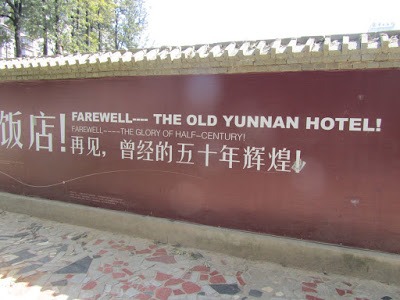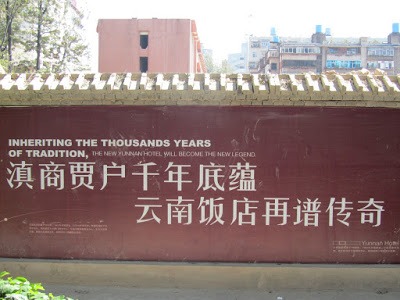While walking in Kunming a few months ago, this wall struck me as quite interesting and made me think of a few things on how we view new, old and how these qualities are associated with traditions. Generally the way we see things in Europe, a building, monument, more or less any architectural structure is old and merits the respect due to tradition if it has been there for a very long time. Several hundreds of years at least. That sounds extremely obvious, although most of European civilisations have been building of stone that can last a very long time.
Stonehenge or similar stone structures in Britanny are amongst the oldest left, believed to have been built around 2,500 BC or so. They are landmarks to early cultures and extremely important to us. They are authentic because they are old and because they have been left unchanged over time. At the same time, no other structures or buildings are left from that time and if we were to rebuild an ancient gallic or British village it would be considered an interesting and possibly educational theme park, and not treated with the same respect given to the real thing.
This is something that struck me the first time I visited China about 4 years ago and this time seeing it proudly written on a wall, I had to snap a few photos and scribble a couple of notes. Last time I visited China, I climbed the 3,000 high Holy Buddhist Mountain of Emei. The mountain has been holy for thousands of years, as you probably know China is steeped in ancient history and extremely proud of their traditions and heritage. The mountain has been sculpted over years, steps all the way to the summit, several large monasteries built on the way, entire murals of intricately sculpted characters in the face of the mountain along certain paths. It was a gorgeous walk and a brilliant experience.
Still, arriving at the summit was somewhat of a disappointment for us occidentals. We had heard of the statue of the buddha at the summit and were expecting a lot from it. It was, though it was also obviously brand new, wooden or something alike, with ugly yellow-gold plating.
Immediately we see fake and it kills everything – well for me at least. The Chinese on the other hand see thousands of years of sacred history and tradition. They know it has been rebuilt recently, but that doesn’t matter. I imagine it’s the idea of it having being built so long ago in the first place and it being rebuilt anew for new generations to enjoy that matters most. Also, the main material used is wood, which doesn’t last as long as stone so tradition, new and old are necessarily seen in different ways for Occidental and Chinese people (possibly Asian, but I haven’t seen everywhere, tell me if you have any other thoughts).
Same for the Yunnan Hotel, which at the time I saw it was a pile of rubble of the old hotel. When it is rebuilt, it will be over 1,000 years old AND brand new at the same time for Chinese people visiting. The pride of the history for the building is there, as well as being able to enjoy all sorts of clean and modern amenities I imagine. For me that’s a paradox, for Chinese people it may well be completely natural.
These are my own observations, I might be completely wrong. Does anyone else have similar experiences about new and old in China or in Asia?





